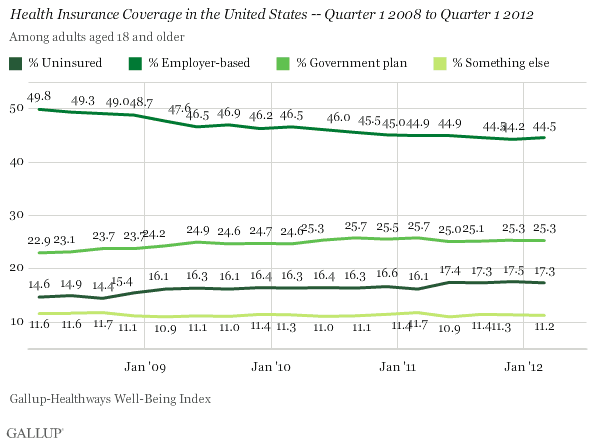WASHINGTON, D.C. -- The percentage of 18- to 25-year-old Americans who do not have health insurance has leveled off at the 24% range, after declining from about 28% after the healthcare law provision allowing adults up to age 26 to stay on a parent's plan took effect.

The uninsured rate for 18- to 25-year-olds first began to decline in the fourth quarter of 2010 after the provision went into effect in September, falling to 26.3% from 28.0% in the third quarter of that year. It then declined further to 24% in the first quarter of 2011 and has remained at about that level since, with the exception of a slight temporary increase the third quarter of 2011.
The uninsured rate for 26- to 64-year-olds has also leveled off. Although, in contrast to 18- to 25-year-olds, the current uninsured rate for 26- to 64-year-olds has plateaued at a higher rate than in January 2008, when Gallup and Healthways first started tracking Americans' health insurance coverage. Roughly one in five Americans in this age group report not having health insurance for the past year.
The percentage of seniors who are uninsured has remained essentially the same over the past four years. Because they qualify for Medicare, very few adults aged 65 and older report lacking health insurance.
Overall, the percentage of all U.S. adults without health insurance was 17.3% in the first quarter of 2012, similar to its levels for the past year, although clearly lower than in 2008, 2009, and 2010. The increase in the percentage of all Americans who were uninsured in the second quarter of 2011 coincides with Gallup's decision to include more cell phone-only respondents in the U.S. beginning April 1. Thus, some of the increase in the uninsured could reflect the greater representation of cell phone-only respondents -- who tend to be younger -- in Gallup samples.
Meanwhile, the percentage of all adults who get their health insurance through an employer has trended down -- now at 44.5%. The percentage who have a government plan through Medicare, Medicaid, or military/veterans' benefits has increased over time -- now at 25.3%.

The percentage of Americans who say they get their health insurance through "something else" -- which could mean they purchase it themselves -- has held steady over the years, near 11%.
Bottom Line
The U.S. Supreme Court last week heard arguments about the constitutionality of the 2010 healthcare law. During the hearings, the justices raised questions about how and if to save different parts of the health law should they decide against the individual mandate. While the final ruling is months away, if the court should decide to strike down the entire law -- which includes the provision allowing those up to age 26 to stay on a parent's health plans -- many young adults who have recently gained coverage would likely lose it.
Still, even as the law remains intact for now, it appears that this part of the law that allows those up to age 26 to stay on a parent's plan may have reached a saturation point. Although millions of people took advantage of this provision when it first went into effect, it does not seem at this point to be having any additional effect on the uninsured rate among young adults. This may be because all or most of those who qualify and have an interest in taking advantage of the provision have already done so. Or, it could be that only those who are most informed have taken part and many others are still unaware of this provision.
About the Gallup-Healthways Well-Being Index
The Gallup-Healthways Well-Being Index tracks well-being in the U.S., U.K., and Germany and provides best-in-class solutions for a healthier world. To learn more, please visit well-beingindex.com.
Survey Methods
Results are based on telephone interviews conducted as part of the Gallup-Healthways Well-Being Index survey Jan. 2-March 30, 2012, with a random sample of 88,908 adults, aged 18 and older, living in all 50 U.S. states and the District of Columbia, selected using random-digit-dial sampling.
For results based on the total sample of national adults, one can say with 95% confidence that the maximum margin of sampling error is ±1 percentage point.
Interviews are conducted with respondents on landline telephones and cellular phones, with interviews conducted in Spanish for respondents who are primarily Spanish-speaking. Each sample includes a minimum quota of 400 cell phone respondents and 600 landline respondents per 1,000 national adults, with additional minimum quotas among landline respondents by region. Landline telephone numbers are chosen at random among listed telephone numbers. Cell phone numbers are selected using random-digit-dial methods. Landline respondents are chosen at random within each household on the basis of which member had the most recent birthday.
Samples are weighted by gender, age, race, Hispanic ethnicity, education, region, adults in the household, and phone status (cell phone only/landline only/both, cell phone mostly, and having an unlisted landline number). Demographic weighting targets are based on the March 2010 Current Population Survey figures for the aged 18 and older non-institutionalized population living in U.S. telephone households. All reported margins of sampling error include the computed design effects for weighting and sample design.
In addition to sampling error, question wording and practical difficulties in conducting surveys can introduce error or bias into the findings of public opinion polls.
For more details on Gallup's polling methodology, visit www.gallup.com.
